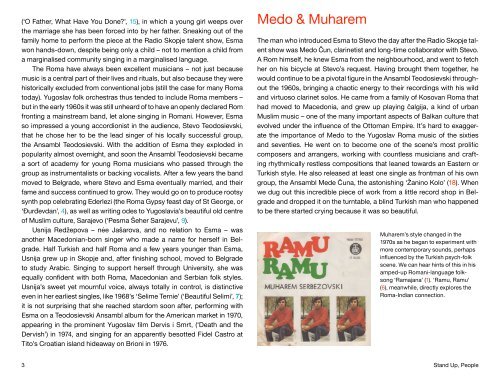gypsy pop songs from tito's yugoslavia 1964 â 1980 - Asphalt Tango
gypsy pop songs from tito's yugoslavia 1964 â 1980 - Asphalt Tango
gypsy pop songs from tito's yugoslavia 1964 â 1980 - Asphalt Tango
You also want an ePaper? Increase the reach of your titles
YUMPU automatically turns print PDFs into web optimized ePapers that Google loves.
(‘O Father, What Have You Done?’, 15), in which a young girl weeps over<br />
the marriage she has been forced into by her father. Sneaking out of the<br />
family home to perform the piece at the Radio Skopje talent show, Esma<br />
won hands-down, despite being only a child – not to mention a child <strong>from</strong><br />
a marginalised community singing in a marginalised language.<br />
The Roma have always been excellent musicians – not just because<br />
music is a central part of their lives and rituals, but also because they were<br />
historically excluded <strong>from</strong> conventional jobs (still the case for many Roma<br />
today). Yugoslav folk orchestras thus tended to include Roma members –<br />
but in the early 1960s it was still unheard of to have an openly declared Rom<br />
fronting a mainstream band, let alone singing in Romani. However, Esma<br />
so impressed a young accordionist in the audience, Stevo Teodosievski,<br />
that he chose her to be the lead singer of his locally successful group,<br />
the Ansambl Teodosievski. With the addition of Esma they exploded in<br />
<strong>pop</strong>ularity almost overnight, and soon the Ansambl Teodosievski became<br />
a sort of academy for young Roma musicians who passed through the<br />
group as instrumentalists or backing vocalists. After a few years the band<br />
moved to Belgrade, where Stevo and Esma eventually married, and their<br />
fame and success continued to grow. They would go on to produce rootsy<br />
synth <strong>pop</strong> celebrating Ederlezi (the Roma Gypsy feast day of St George, or<br />
‘Ðurd¯ evdan’, 4), as well as writing odes to Yugoslavia’s beautiful old centre<br />
of Muslim culture, Sarajevo (‘Pesma Šeher Sarajevu’, 9).<br />
Usnija Redžepova – née Jašarova, and no relation to Esma – was<br />
another Macedonian-born singer who made a name for herself in Belgrade.<br />
Half Turkish and half Roma and a few years younger than Esma,<br />
Usnija grew up in Skopje and, after finishing school, moved to Belgrade<br />
to study Arabic. Singing to support herself through University, she was<br />
equally confident with both Roma, Macedonian and Serbian folk styles.<br />
Usnija’s sweet yet mournful voice, always totally in control, is distinctive<br />
even in her earliest singles, like 1968’s ‘Selime Ternie’ (‘Beautiful Selimi’, 7);<br />
it is not surprising that she reached stardom soon after, performing with<br />
Esma on a Teodosievski Ansambl album for the American market in 1970,<br />
appearing in the prominent Yugoslav film Dervis i Smrt, (‘Death and the<br />
Dervish’) in 1974, and singing for an apparently besotted Fidel Castro at<br />
Tito’s Croatian island hideaway on Brioni in 1976.<br />
Medo & Muharem<br />
The man who introduced Esma to Stevo the day after the Radio Skopje talent<br />
show was Medo Č un, clarinetist and long-time collaborator with Stevo.<br />
A Rom himself, he knew Esma <strong>from</strong> the neighbourhood, and went to fetch<br />
her on his bicycle at Stevo’s request. Having brought them together, he<br />
would continue to be a pivotal figure in the Ansambl Teodosievski throughout<br />
the 1960s, bringing a chaotic energy to their recordings with his wild<br />
and virtuoso clarinet solos. He came <strong>from</strong> a family of Kosovan Roma that<br />
had moved to Macedonia, and grew up playing čalgija, a kind of urban<br />
Muslim music – one of the many important aspects of Balkan culture that<br />
evolved under the influence of the Ottoman Empire. It’s hard to exaggerate<br />
the importance of Medo to the Yugoslav Roma music of the sixties<br />
and seventies. He went on to become one of the scene’s most prolific<br />
composers and arrangers, working with countless musicians and crafting<br />
rhythmically restless compositions that leaned towards an Eastern or<br />
Turkish style. He also released at least one single as frontman of his own<br />
group, the Ansambl Mede Čuna, the astonishing ‘Žanino Kolo’ (18). When<br />
we dug out this incredible piece of work <strong>from</strong> a little record shop in Belgrade<br />
and dropped it on the turntable, a blind Turkish man who happened<br />
to be there started crying because it was so beautiful.<br />
Muharem’s style changed in the<br />
1970s as he began to experiment with<br />
more contemporary sounds, perhaps<br />
influenced by the Turkish psych-folk<br />
scene. We can hear hints of this in his<br />
amped-up Romani-language folksong<br />
‘Ramajana’ (1). ‘Ramu, Ramu’<br />
(6), meanwhile, directly explores the<br />
Roma-Indian connection.<br />
3 Stand Up, People



